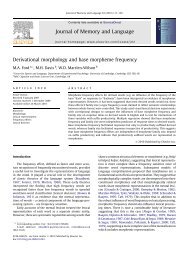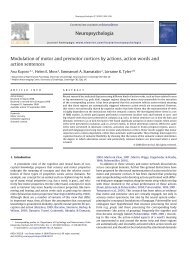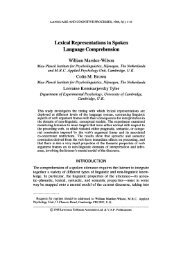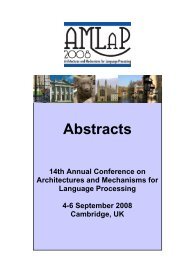Towards a psychological basis for a theory of anaphora - Centre for ...
Towards a psychological basis for a theory of anaphora - Centre for ...
Towards a psychological basis for a theory of anaphora - Centre for ...
Create successful ePaper yourself
Turn your PDF publications into a flip-book with our unique Google optimized e-Paper software.
esolution, but it cannot, nonetheless, probe the<br />
internal structure <strong>of</strong> the mapping<br />
-<br />
process in the same<br />
-<br />
way that on-line probes during the presentation <strong>of</strong> an<br />
(auditory) input are able to.<br />
These reservations aside, the research on anaphor<br />
resolution in written texts seems consistent with- the<br />
approach we have taken here. The series <strong>of</strong> studies, <strong>for</strong><br />
example, by Caramazza and his colleagues (e.g.,<br />
Caramazza, Grober, Garvey, & Yates, 1977; Caramazza &<br />
Gupta, 1979) confirm that a variety <strong>of</strong> different <strong>for</strong>ms<br />
<strong>of</strong> constraints are brought together in the resolution <strong>of</strong><br />
a lexically ambiguous anaphoric expression. These<br />
studies (see also Cowan, this volume) typically use<br />
isolated sentences <strong>of</strong> the <strong>for</strong>m "The criminal attacked<br />
the policeman because he was stupid", where the pronoun<br />
''he" is ambiguous. The experimsnts show that a variety<br />
<strong>of</strong> factors - including, among others, the semantics <strong>of</strong><br />
the verb in thz first clause, the nature <strong>of</strong> the<br />
connectives used ( "and" vs. "becauszWl, and the<br />
ordering <strong>of</strong> the main and subordinate clauses - can<br />
affect subjects' judgements about the antecedent <strong>of</strong> the<br />
pronoun. One clear result <strong>of</strong> these studies is that<br />
sentential configurational factors - as reflected, <strong>for</strong><br />
example, in the "parallel functionn constraint (C.£. ,<br />
Cowan, this volume) - are not by themselves sufficient<br />
to determine CO-reference. A dominant consideration is<br />
always the pragmatic plausibility <strong>of</strong> an antecedent<br />
assignment, in the light <strong>of</strong> the scenario implied in the<br />
first clause and <strong>of</strong> the properties predicated <strong>of</strong> the<br />
pronoun elsewhere in tlle second clause.<br />
Another type <strong>of</strong> experiment, exemplifisd by the work<br />
<strong>of</strong> Garrod and San<strong>for</strong>d and <strong>of</strong> Clark and Haviland, has<br />
used short texts to examine the role <strong>of</strong> inference in the<br />
l inkage <strong>of</strong> anaphor ic elements to the preced inq context.<br />
Haviland & Clark (1974) and Clark & Haviland (1977)<br />
focussed on what they call "bridging inferences", using<br />
contrasts like the following:<br />
la) Mary unpacked the picnic things,<br />
lb) Mary unpacked the beer,<br />
2) The beer was warm. --<br />
Overall "comprehension time" <strong>for</strong> sentence (2) is slower<br />
when it follows (la) than when it follows (Lb). This is<br />
taken as evidence, first, that the comprehension <strong>of</strong> the<br />
anaphor ic nounphrase "The beerH (its anaphor iciCy being<br />
indexed by the presence <strong>of</strong> the definite article)<br />
involves its rinkage to the prior text, and, second,<br />
that this linkage requires a bridging inference (in this<br />
case that; the picnic things must have included some<br />
beer) when the noun has not been explicitly mentioned<br />
be<strong>for</strong>e. Such inferences, it is assumed, take time,






